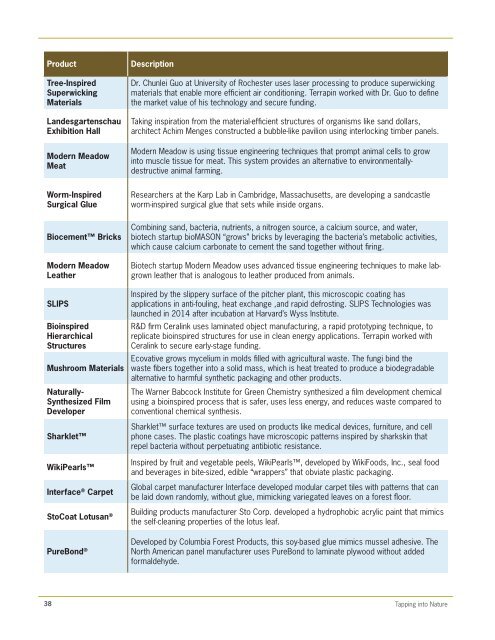Tapping-into-Nature-2015p
Tapping-into-Nature-2015p
Tapping-into-Nature-2015p
Create successful ePaper yourself
Turn your PDF publications into a flip-book with our unique Google optimized e-Paper software.
ProductTree-InspiredSuperwickingMaterialsLandesgartenschauExhibition HallModern MeadowMeatDescriptionDr. Chunlei Guo at University of Rochester uses laser processing to produce superwickingmaterials that enable more efficient air conditioning. Terrapin worked with Dr. Guo to definethe market value of his technology and secure funding.Taking inspiration from the material-efficient structures of organisms like sand dollars,architect Achim Menges constructed a bubble-like pavilion using interlocking timber panels.Modern Meadow is using tissue engineering techniques that prompt animal cells to grow<strong>into</strong> muscle tissue for meat. This system provides an alternative to environmentallydestructiveanimal farming.Worm-InspiredSurgical GlueBiocement BricksModern MeadowLeatherSLIPSBioinspiredHierarchicalStructuresMushroom MaterialsNaturally-Synthesized FilmDeveloperSharkletWikiPearlsInterface ® CarpetStoCoat Lotusan ®PureBond ®Researchers at the Karp Lab in Cambridge, Massachusetts, are developing a sandcastleworm-inspired surgical glue that sets while inside organs.Combining sand, bacteria, nutrients, a nitrogen source, a calcium source, and water,biotech startup bioMASON “grows” bricks by leveraging the bacteria’s metabolic activities,which cause calcium carbonate to cement the sand together without firing.Biotech startup Modern Meadow uses advanced tissue engineering techniques to make labgrownleather that is analogous to leather produced from animals.Inspired by the slippery surface of the pitcher plant, this microscopic coating hasapplications in anti-fouling, heat exchange ,and rapid defrosting. SLIPS Technologies waslaunched in 2014 after incubation at Harvard’s Wyss Institute.R&D firm Ceralink uses laminated object manufacturing, a rapid prototyping technique, toreplicate bioinspired structures for use in clean energy applications. Terrapin worked withCeralink to secure early-stage funding.Ecovative grows mycelium in molds filled with agricultural waste. The fungi bind thewaste fibers together <strong>into</strong> a solid mass, which is heat treated to produce a biodegradablealternative to harmful synthetic packaging and other products.The Warner Babcock Institute for Green Chemistry synthesized a film development chemicalusing a bioinspired process that is safer, uses less energy, and reduces waste compared toconventional chemical synthesis.Sharklet surface textures are used on products like medical devices, furniture, and cellphone cases. The plastic coatings have microscopic patterns inspired by sharkskin thatrepel bacteria without perpetuating antibiotic resistance.Inspired by fruit and vegetable peels, WikiPearls, developed by WikiFoods, Inc., seal foodand beverages in bite-sized, edible “wrappers” that obviate plastic packaging.Global carpet manufacturer Interface developed modular carpet tiles with patterns that canbe laid down randomly, without glue, mimicking variegated leaves on a forest floor.Building products manufacturer Sto Corp. developed a hydrophobic acrylic paint that mimicsthe self-cleaning properties of the lotus leaf.Developed by Columbia Forest Products, this soy-based glue mimics mussel adhesive. TheNorth American panel manufacturer uses PureBond to laminate plywood without addedformaldehyde.38<strong>Tapping</strong> <strong>into</strong> <strong>Nature</strong>


